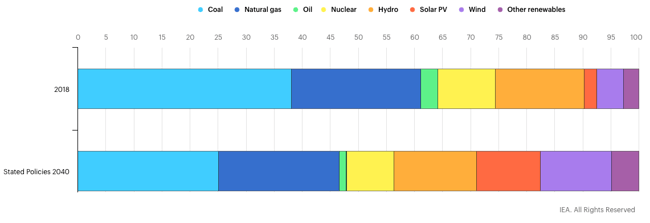Make the most of your thermal power plants
Everybody is talking about renewable energy sources these days and rightly so: Investors are jumping on board, as their market share rises each year and the grade of innovation is at an all-time high. On the other hand, conventional thermal power sources get bad press due to the unsustainable nature of the resources they consume. But with a share of more than 70% of total capacity generating almost 5000 GW, they still remain the backbone of the energy market. The big growth phase is over, but with their sheer flexibility capacity alone they will stay a major player in future energy markets.

Due to environmental concerns and the promotion of renewables, the combined share of coal, gas, and nuclear power plants will shrink to an estimated 55% by 2040, according to the IEA. But with global energy consumption still on the rise, can wind and solar take over the increasing demand all by themselves?
Energy generation in renewables heavily depends on fluctuating environmental conditions like wind and the sun and therefore cannot simply produce more energy on cue. The only way to handle this energy fluctuation is to balance it with other flexibilities. Even though stationary battery storage and pumped storage can help out by releasing stored energy when needed, thermal power plants have the biggest flexibility potential by far and with retrofitting measures it is possible to increase their flexibility. Having higher system-wide flexibility helps to accommodate solar and wind energy into the energy system. But let us first discuss in more detail what a thermal power plant actually is.
How does a thermal power plant work?
Most thermal power plants are steam power plants that produce electricity. Based on two heat reservoirs with sufficient temperature differences, thermal energy is first converted into usable kinetic energy and then into electrical energy by a generator. Thermal plants include conventional, fossil power plants but also modern CHP (combined heat and power) plants that run on various fuels, including waste, biogas, and biomass. Many CHP plants optimize their operations to meet thermal demand, while the electricity generated is seen as a byproduct.
Flexibility from thermal power plants
The International Energy Agency defines the concept of flexibility of a power system as "the extent to which a power system can modify electricity production or consumption in response to variability, expected or otherwise". Positive flexibility means the capacity to increase energy generation or reduce usage, while negative flexibility refers to decreasing energy generation or increasing usage. Either way, the grade of flexibility of a system depends on how quickly it can adapt generation or usage in response to external forces. These external signals include peaks and valleys in demand or changing prices on balancing or spot markets. Market participants can enhance their performance by adjusting supply or demand in order to take advantage of favourable prices.
Until the widespread use of battery storage, there is no way around the vast potential of thermal power plants, when it comes to utilizing flexibility in the energy market. While in renewable energy sources flexibility is a precious commodity, in thermal power plants it can be developed at a low cost. A great way to incentivise thermal plant operators to improve the flexibility of their plants is to get them connected to the intraday energy market. By promoting flexibility, thermal power plants can play a new positive role in the energy transition, as they enable us to integrate renewable energy with their unsteady nature of energy generation into our grids.
When operating a thermal power plant, you don’t want to waste a single gram of resources, as they are finite. Also, with nuclear energy, you want to have as few plants as possible to minimize the number of repositories you need to construct. Using the full flexibility potential of conventional power plants can increase the efficiency of their energy production and is just as important as introducing new renewable energy technologies. Studies have indeed shown that increased flexibility in thermal power plants results in lower emissions. The primary reason for these reductions is that the usage of renewables can be increased while less fuel is burned for heat and electricity production. But the lower fuel usage also signifies an increase in overall energy efficiency as CHP units are able to substitute less efficient energy production. So the best way to save resources and limit the environmental impact is to increase and utilize the energy system’s potential for flexibility.
Raise profits with flexibility markets
All energy generation, storage and consumption have some level of flexibility and power plant operators have a great potential to monetize it. So how can flexibility be marketed and the profits be realized? Nowadays, many types of short-term markets exist, with each designed for distinct purposes:
Balancing markets are the most well-known energy markets out there as balancing requirements have been around the longest. They were established with the explicit purpose of maintaining grid stability through flexibility. With lead times in seconds or minutes, this poses a challenge to some thermal power plants due to their slower reaction time. With their high complexity and entry barriers, these markets are not easy to participate in, and they are basically an oligarchy, as prices are generally defined by a small handful of big players.
Day-ahead and intraday auctions are also used for short-term power trading for all delivery periods in the following day or twice on the same day for dispatchable power of thermal and hydro plants. Due to their long lead times, they cannot respond to unexpected fluctuations in supply or demand and are therefore rendered less effective in terms of delivering flexibility.
Continuous intraday markets grew alongside renewable energy as the traditional auctions were not designed to trade the short-term products that become so critical when environmental conditions like wind and solar dominate energy generation. Being able to buy and sell until the last minute, the intraday market enables you to trade these short-term products and helps you balance your energy portfolio. Compared to other markets, the rules are less rigid and the barriers to entry are much lower. It is the most democratic market - a market for the underdogs. The biggest producers don’t have absolute leverage here, as prices are determined by overall market dynamics. Despite the popularity of the balancing markets, intraday trading is the best opportunity to make the most of your flexibility.
An initial spark for modern energy trading
Entering the intraday market is no easy task if you do it yourself. Increased volume and volatility, an ever-growing number of products, and the move to trading in near real-time make it extremely challenging for manual traders to succeed. To keep up with the competition, there is no way around implementing algorithmic trading and automation of the full trading value chain. Running your own intraday trading operations requires a complex setup including software, sophisticated data analysis and a specialized team, but the payoff speaks for itself.
Are you all fired up to get into trading and eager to market your thermal power assets? But you are not sure how to get started? Or do you just want to avoid the hassles of running your own modern intraday trading desk? Here at enspired, we want to assist you on your way to profiting from your increased flexibility. Our team of experts in AI-based energy trading can help you get started in no time with full transparency and no risk.
Book a non-binding call today.
